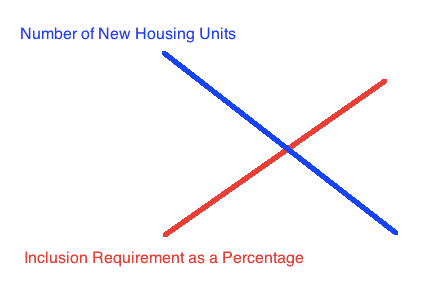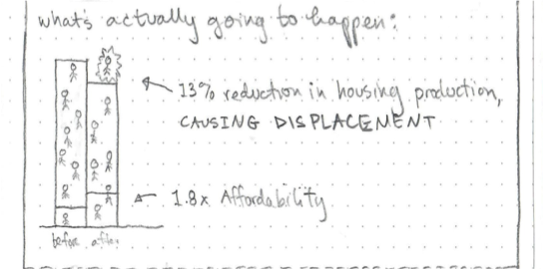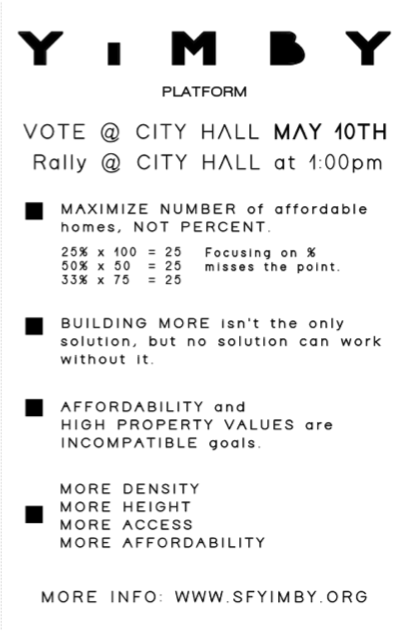Correction: We Need More Housing, Not More Zoning
That headline is pretty loaded. What does it mean? Don’t we want more zoning capacity in order to build more housing? Over the last week or so in conversations with different people about housing and zoning and mandates being pushed by the Mayor, I realized that there has been confusion created among people in the housing and growth debate in Seattle. And I am part of that because, I, like many others, have called for upzones. I think that lots of people, if asked, on all sides of the debate, would agree that what I and other advocates were pushing for is “more” or “higher” zoning. In fact, in one interview I was asked , “But don’t developers and builders want more zoning? Isn’t that how they make more money?” No. They don’t. What we’re asking for is not more zoning, but more housing, or at least the room and opportunity to make more housing. It’s different. And I think we all need to start making the distinction.
Years ago I worked as the County’s Tobacco Tzar, and my office and I did everything we could to enforce existing laws, make new ones, and develop strategies to make King County “the hardest place to smoke and the easiest place to quit in the country.” You’d think that slogan would have been hailed as genius. It wasn’t. Instead the head of the public health department earnestly pushed back on the “hardest place” part. It seemed offensive. Forget about the fact that we touted statistics the showed that smoking related deaths were higher than things like drug overdoses, car accidents, and gun violence — combined.
Along with our more aggressive enforcement efforts we also engaged with different potential partners to create voluntary programs. One idea I had was to offer developers and builders more building height in exchange for making their buildings smoke-free. At the time, I felt like incentive zoning was a good idea especially if the bargaining with builders was mutually beneficially and a good exchange of value. I figured more Floor Area Ratio (FAR) was what they wanted. If we let them build taller and bigger, then they’d for sure prohibit smoking in their buildings. Like most things, we were ahead of our time (I got into a lot of trouble for a front page Seattle Times article on our efforts on this that was linked on the Drudge Report). Almost all apartment buildings are smoke-free these days.
But then, we heard a lot of skepticism. I was surprised to find out that more FAR was not huge advantage I thought it would be. Instead developers had lots of other things on their minds besides “more zoning.” While density was on the list so were,
- flexibility with parking requirements
- a predictable and quick permit process
- flexiblity in zoning and land-use code
- assembled parcels
- pooled open space
- tax breaks and low-cost loans
Many builders and developers then told me what I know so well now: additional FAR comes at the cost of extra construction and whether it has value to offset the benefit being given (smoke-free housing, affordable housing or whatever) depends on where the project is located. I remember one well known and experienced developer telling me the additional height on one sample parcel didn’t matter because of parking requirements that would mean having to excavate onsite parking. That meant almost any increase in height was meaningless.
That answer, “it depends,” was a little frustrating at the time. And our idea didn’t really go anywhere. In the end, builders and building owners and managers have gone smoke-free because it reduces risks and costs. And tenants themselves don’t really care, choosing, mostly not to smoke in their own homes. The change we wanted happened, I think, because as we passed broader limits on smoking in public, those expectations expanded into the market for private spaces too. Smoke-free housing is happening because people are demanding it and the market is responding.
I feel like I have contributed to the confusion that seems to permeate every level of the housing discussion and especially about Mandatory Inclusionary Zoning (MIZ). Yes, more people, living in more units, in smaller spaces, in a wider variety of housing types is what we want. But zoning itself isn’t what we want. We want the ability to innovate housing solutions to meet the demands of people who are shopping for housing, whether they have a lot, some, or fewer dollars to spend on the product. More square footage isn’t necessarily a gift. But in all our talk about more housing, the discourse has slowly quantified that call into a demand for “more zoning.” The truth is we ought to completely abolish zoning all together.
This weird rhetorical shift meant that the so called Grand Bargain became an exchange of square feet for a fixed percentage of rent restricted units or a fee instead. The real world doesn’t work like that. So now we’re arguing over the relative value of square feet versus the costs of additional construction and lower rents. This is a narrow view of what value means in a real estate transaction or in housing production, and the argument is kind of a beside the point. We don’t want more zoning, we want more housing. We need more housing. Obsessing on zoning is making us fight about that, when what should be working together on is figuring out how we produce more.
City Inside/Out: Mayor Murray Follows Sawant in Regulatory Overreach
I was on a panel last week on the Seattle Channel’s City Inside/Out, perhaps the best public affairs show in the region, to talk about the latest scheme hatched at City Hall to regulate housing. It isn’t much of a surprise that the proposed legislation to impose what amounts to a form of rent control in Seattle is being supported by Councilmember Sawant, but it is surprising to see the uncritical support of her efforts by the Mayor. The legislation is the worst kind, born out of anecdote rather than data, duplicative of existing programs, and, ultimately, illegal. But it’s good politics, and lately the Mayor seems to favor good politics over good policy. And like Mandatory Inclusionary Zoning (MIZ), the infeasible scheme to require rent restricted units for some increase in zoning, this legislation was written by a select few and excluding the very people most impacted by the new rules.
The proposed legislation we discussed on the panel would prevent landlords from increasing rent when a tenant complains about lack of maintenance in their unit that might cause the unit to be below legal standards of habitation. The problem is that the City already has the Rental Inspection Ordinance (RIO) which apparently has failed to catch substandard buildings (even when inspected) and has only registered about a third of rental properties in the City. All this would do is add more to the City’s to do list with no additional resources. And it’s an incentive to do nothing. If a housing owner decides to raise the rent, and a tenant complains, it doesn’t mean the repairs will happen. How would they be paid for?
The fact is that operating costs are outpacing rent increases. Taxes, utilities and other costs are climbing quickly. Those costs include maintenance. The only way to cover operating costs is from rent. When rents don’t keep up, buildings fall apart. The proposal does nothing to solve that problem, and in fact it would incentivize avoiding making improvements along with limiting rents.
More importantly, the proposal is illegal grandstanding by Sawant, and ill conceived piece of legislation that will provoke law suits. Like MIZ, the Mayor seems bent on using his power to score political points without actually accomplishing anything beneficial for renters or people looking for housing. We’ve come to expect that from Councilmember Sawant, but the Mayor appears to be following her example.
The right thing to do, is to allocate resources to encourage and incentivize housing owners and operators make needed repairs, not make it harder to do so. A loan program, expanding the Multifamily Tax Exemption (MFTE) program so it could be used for improvements, and perhaps funds for the City to acquire and improve truly troubled buildings. All of these things would be collaborative solutions that would make life better for renters and keep their rents low. But that’s hard work. And there is no villain or victim, just people working together trying to make life better. Boring.
A Real Grand Bargain: Leave Single-Family Alone!
Let’s face it, zoning is obsolete; it’s a 20th century solution to a 19th century problem, the encroachment of intense and messy uses of land next to less intense uses of land. In the last century, almost a 100 years ago, toxic industrial uses and people shared the same block. Zoning was initially a kind of public health intervention. But we don’t need it anymore. I’ve been saying this for years. Many years, and I was sometimes being derided by professional planners being told, “Don’t say that,” or “You want to be Houston?”
The idea that geographic parts of our city are zoned for use and standards–like single family or NC 85–is the relic of ancient zoning history. Zoning came about to separate use. We need to do the opposite. In a walk down any block in our city we should be able to see many uses and many typologies pushed together and even on the same lot. It’s going to take time to get away from the idea of preventing a “pig in the parlor” to welcoming the whole herd in the house.
But all the attention lately of trying to put more duplexes and triplexes in single-family neighborhoods, or deleting the single-family zone is becoming a distraction. Let me explain.
Back in 1989 the Washington State passed the Growth Management Act (GMA), legislation largely aimed at preventing the loss of habitat, farmland, and open spaces to sprawl. The operating mechanism of the GMA was to push and pour and pull growth in to cities, places where there was already dense population.
In Seattle, the approach was to create an analog to the GMA; protect single-family neighborhoods from density and push and pour and pull growth into urban villages, places with the zoning for density already. This was the real Grand Bargain struck between Mayor Norm Rice and single-family neighbors in Seattle’s comprehensive plan. That Bargain lead to years of neighborhood planning and neighborhood plan implementation. A similar effort went into planning around Transit Oriented Development (TOD).
In both cases the point was in exchange for conceding big changes in the urban villages and around stations, neighborhoods would keep their yards, views, and idyllic neighborhoods. Light rail station areas and urban villages would be upzoned and lots of growth would happen there and the City would put infrastructure investments into the areas that “took” the growth. Everyone came out of this process a winner, and even die hard opponents of growth and change found themselves arguing for things (like parks, and sidewalks) rather than waging ideological opposition to growth and big buildings.
The problem is that we have never really pushed as much growth into urban villages and transit stations. Before too long, this idea, growing big in every other zone but single-family dissipated. There was not meddling by single-family neighbors in every damn thing that was getting permitted. The murder of microhousing is but the last and most obvious example: it was killed by Councilmember O’Brien not at the behest of people living in it or really even near it, but people in single-family neighborhoods down the road from it.
Beacon Hill station area is another example. Twenty years after we were sitting in meetings doing neighborhood planning, the Red Apple is still the Red Apple with a big parking lot directly across from a billion dollar investment in light rail. This is largely because the upzones that could and should have happened all around Beacon Hill station never were executed.
Do I want the abolition of zoning? Yes. When do I want it? Now.
But the problem is that we’re draining away energy picking fights with neighbors about duplexes and triplexes. That’s a waste of time. Neighbors should be told, “Hands of multifamily zones!” No more design review, no more meetings, no more zoning in those areas already growing rapidly. I am not against upzoning single-family neighborhoods or abolishing most single-family designated zones turning them say into low-rise 1 zones. But that’s terrible politics. It’s going to be a battle to get modest uponzes part of Mandatory Inclusionary Zoning (MIZ) in areas where there is no single-family.
Wading into open warfare with angry neighbors is not a good use of our resources right now.
So, if I was Mayor, I’d let the big downtown developers have their Grand Bargain with the non-profit housing developers. The City would give the big kids what they wanted provided they just write their checks to the Housing Development Consortium (HDC). Let’s just cut out the wasteful middle man. Many, many dollars of fines, er, fees will be wasted in bureaucratic nonsense trying to distribute Vulcan’s pay out for its upzones. Just give the money directly to the HDC or better yet, make the money a source in an actual development. Done.
Next, I’d scrap the ridiculous, wasteful, and inflationary MIZ idea. Done. Over.
Then I’d tell single-family neighbors they don’t have to worry about upzones of single-family or any triplexes or duplexes. However, down the road, in the urban villages, we’re doing away with zoning all together and creating Spontaneity Hubs in which the only rules that would apply would be the rules of the market and health and safety. Done.
There would be no hand wringing design review in the hubs. No limits on height, bulk, or scale. In the Hubs anything would be allowed that would create housing, office space, retail, incubator space, light industrial, and even bowling alleys and roller rinks. Anything. And there might even be negative taxes for arts and cultural spaces, improvised housing solutions for homeless people and families, and other public benefits.
That is truly a Grand Bargain and would, I think, keep us busy far into the 20 year period conceived up by the Mayor’s proposals in the Comprehensive Plan. But we need to get started. When we’re done with that, we can turn our attention to single-family neighborhoods.
Folkenomics: The Mything Middle
A recent editorial I came across, “Election Season Reveals Rampant Economic Illiteracy Among Voters,” bemoans what I’ve been noticing for years: a deep and wide ignorance and rejection of basic economic principles among the American public and more specifically, voters. The article fails to put together a very good argument, instead it points to relevant data and does some head scratching. The big question is do we try to educate the public? Is it too late? What’s the alternative? How do we deal with the real damage being done to housing policy by politicians responding to what I’ve called, folkenomics, a popular belief in bad science that benefits narrow interests.
What’s the data tell us?
An American Action Network poll finds that . . . half of Democratic voters are perfectly comfortable with the idea of the government owning and/or controlling the private sector. More than half of Democrats (57%) say that socialism has a positive impact on society.
For left leaning ideologues it’s as if the Cold War and the collapse of the Soviet Union never happened. Remember the Iron Curtain? No?
But how about Republicans? Republicans are supposed to support market economics, right?
Republicans are more hostile to free trade than Democrats. In Pennsylvania, for example, 53% of GOP voters say trade with other nation’s “takes away U.S. jobs.” Just 42% of Democratic voters feel that way. The same gap has shown up in just about every other state where this question was asked of primary voters.
The disdain for and rejection of the reality of market forces seems to know no partisan bounds.
Of course, policies impacting the economy should be debated. Some will work better than others. But should the City, for example, own and operate housing in Seattle? Is that a credible solution? I don’t have polling data, but I’d guess a significant number of Seattle voters would want the City to start owning and operating lots of housing and controlling prices for what it doesn’t acquire.
I believe that a cash subsidy, a transfer of wealth as it were from single-family homeowners to poorer renters, is good public policy. But that’s based on my intuition about the manifestly wasteful use of limited resources by owners of big pieces of land with two or three people living on that land. Single-family housing is a luxury enjoyed at the expense of the poor; such inefficiency in the economy shouldn’t be subsidized it should be heavily taxed.
But our politics in Seattle dictates that we extract — extort really — money out of renters to pay for housing for other renters. This is Mayor Murray’s policy, Mandatory Inclusionary Zoning (MIZ). Developers won’t pay for rent restritcted housing under MIZ, renters will. Rather than identify the single greatest market failure in our housing economy, the government sponsored monopoly of single-family homeowners and making them pay for their entitlement, the Mayor is bending the City bureaucracy to impose costs and requirements on new multifamily family housing that will raise its price to subsidize other multifamily housing. He’s taxing new renters to subsidize other new renters. He’s robbing Peter in B17 to pay for Paul’s rent in B18.
This foolish and wasteful pursuit will almost entirely absorb the conversation about housing in the city for the foreseeable future, ignoring the fact that we have market based tools at our disposal that outperform MIZ like the Multifamily Tax Exemption and that we have vast swaths of City and publicly owned land that could be repurposed for housing and paid for with public financing, the cost of which would be paid by households luxuriating on single-family lots. Socialism? No, these ideas make the market more efficient by incentivizing efficiency and disincentiving inefficiency.
Back to the question, should we educate people about why they are mistaken to subscribe to folkenomics? I don’t think we have a choice. Politics dictates (and I learned many years ago working on campaigns) that to win a political fight, one identifies and sorts out people who already agree, mobilizes them, converts the wavering, in discourages turnout from opponents. That’s how one wins a political campaign. Trying to persuade people, in a rather short time frame, to make a 180 turn ideologically is folly. It’s inefficient.
But what happens when the scientifically tested view — more housing lowers prices — simply isn’t politically supportable because dominant interests are harmed by that science? Here’s a amendment to the sorting theory of politics above. Let me also say that some of the greatest challenges to the misalignment of economic interest and scientific facts (e.g. Copernican astronomy and the Papacy, slavery and the agrarian economy of the south, universal suffrage and male power, health and the tobacco industry) took a long time to change — an often involved violent and rending clashes in the streets.
It’s not pretty, but we must find — concoct — a myth that is as believable as the one that supports MIZ — that by taxing and burdening developers with penalties, fees, fines, and requirements we’ll make housing cheaper for consumers — with a myth that is as believable, as soothing and salutary to the dominate class but that does no harm to the underlying science of supply and demand. That myth must appeal to inherent, innate, and heartfelt intuitions about living life like fairness, reward for hard work, and paying our own way.
Building a heartwarming myth that supports good housing science runs counter to everything we’re trained to believe; bad ideas should respond to dosages of fact like a cancer shrinks from chemotherapy. People should do the right thing.
But creating myths has been done to great effect for darker purposes. The narrative that we need yards, light and air, views from everywhere, and design that is pleasing to whoever shows up at design review meetings is accepted as truth to support the current paradigm. Can’t we come up with a better story that also supports the facts? Our future may depend on it.
The featured image is from a brilliant animated version of George Orwell‘s Animal Farm. Yes, it’s that bad.
Sonja Trauss on MIZ: What’s Actually Going to Happen
Last Thursday one of my heros, Sonja Trauss, was in town because I invited her to speak at the Seattle Builders Council dinner. We all had a good time. And Trauss did not disappoint with her presentation, challenging the audience to talk differently about housing, and profit, and how we need more housing to solve our housing price problems. Trauss and I always compare notes. Probably absent from anyone’s coverage will be what she said about Mandatory Inclusionary Zoning: it won’t work. Or at least it won’t help solve the problem the Mayor and his friends and his staff are insisting they want to solve, high housing prices. The Mayor wants a good political solution. Bingo! You got it! We punish developers, build some affordable units, and call it a compromise. Good work! But what happens to housing prices and housing scarcity. Those problems get worse. Trauss summed it up perfectly with one slide.
What are the actual numbers, not just the concept of 25% of 100 units = 25 units and 50% of 50 units = 25 units? We don’t know because the City has not shared any numbers with us. None. And they have not been forthcoming with their methodology. But the concept, the principle in basic math, that increasing the percentage of something while the number goes down is basic to the reason why MIZ won’t make overall housing prices go down; in fact it’ll make the problem worse.
Trauss included these arrows on her first slide that demonstrate a simple truth that hasn’t penetrated the skulls of anyone downtown: when you demand more inclusion, then you get fewer projects, and that means less housing, market rate and affordable over all. We’ve been around and around this concept with the Multifamily Tax Exemption; when you increase the costs to participate in the program by increasing the level of subsidy required (this happens when Council keeps lowering the threshold of Area Median Income) you don’t get more deeply affordable units, say at 40 percent of Area Median Income (AMI), you get fewer units of 60 percent AMI priced units.
This happens because projects simply won’t work when the costs of the inclusion exceed the additional height or floor area ratio (FAR) being added. Trauss’ point is that when we obsess about the percentage of inclusion, we forget the fact that when that drifts too high, we get no projects at all, fewer units, scarcity, and higher prices. There it is in simple pictures. Maybe this will help get the idea across: we need more housing, not political gimmicks.







